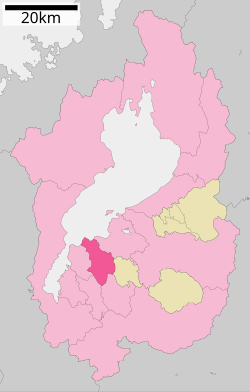|
Yasu, Shiga
 Yasu (野洲市, Yasu-shi) is a city located in Shiga Prefecture, Japan. As of 1 October 2021[update], the city had an estimated population of 50,695 in 20695 households and a population density of 630 persons per km2.[1] The total area of the city is 80.14 square kilometres (30.94 sq mi). GeographyYasu is located in south-central Shiga Prefecture, on the eastern shore of Lake Biwa. The city skyline is dominated by Mount Mikami, also known as "Ōmi Fuji" from its resemblance to Mount Fuji. Parts of the city are within the borders of the Mikami-Tanakami-Shigaraki Prefectural Natural Park. Neighboring municipalitiesShiga Prefecture ClimateYasu has a Humid subtropical climate (Köppen Cfa) characterized by warm summers and cool winters with light to no snowfall. The average annual temperature in Yasu is 14.5 °C. The average annual rainfall is 1430 mm with September as the wettest month. The temperatures are highest on average in August, at around 25.3 °C, and lowest in January, at around 3.1 °C.[2] DemographicsPer Japanese census data,[3] the population of Yasu doubled from 1960 to 2000 and has plateaued since then.
HistoryYasu is part of ancient Ōmi Province and the route of the Tōsandō (later the Nakasendō) highway connecting Heian-kyō with the eastern provinces passed through the area; however, there were no shukuba within the city limits. Most of the area was tenryō territory under direct control of the Tokugawa shogunate in the Edo period. The minor feudal domain of Mikami Domain controlled by a cadet branch of the Endo clan had its jin'ya in Yasu, but its estates were widely scattered in other locations, mostly in Izumi province. The town of Yasu was established with the creation of the modern municipalities system on April 1, 1889. Yasu annexed the village of Mikami in 1942, and the villages of Shinohara and Gio in 1955, On October 1, 2004, Yasu absorbed the neighboring town of Chūzu (also from Yasu District) and was elevated to city status. Yasu District was dissolved as a result of this merger. Mount Mikami (三上山), standing at an elevation of 432 meters, is affectionately known as "Omi Fuji (近江富士)," as referenced by Murasaki Shikibu (紫式部) in her poem: "Upon setting forth, I gaze upon Mikami's mountain; though snowless (打ち出でて 三上の山を 詠れば 雪こそなけれ 富士のあけぼの), it rivals Fuji at dawn." Historically cherished, this mountain is also known as "Mukade-yama" due to the legend of the giant centipede slain by Fujiwara Hidesato (Tawara Toda). It holds a storied past with mentions in the Kojiki and Engishiki, and has been celebrated in waka poetry. Matsuo Basho also composed a verse about it: "In Mikami's summer, its form is well known (三上山のみ夏知れる姿かな)." The Mikami Shrine, situated at the mountain's base, venerates Mount Mikami as a sacred mountain. According to shrine tradition, on the 18th day of the 6th month in the 6th year of Emperor Kōrei's reign, the deity Amanomikage-no-mikoto descended upon the summit, and the shrine priest (Mikami no Hafuri) enshrined the mountain as a divine body (Kannabi). Archaeological excavations from the Meiji to Showa periods uncovered 24 bronze bells at the foot of Mount Mikami, suggesting that rituals have been conducted in the area since ancient times. GovernmentYasu has a mayor-council form of government with a directly elected mayor and a unicameral city council of 18 members. Yasu contributes two members to the Shiga Prefectural Assembly. In terms of national politics, the city is part of Shiga 3rd district of the lower house of the Diet of Japan. EconomyThe economy of Yasu is centered on agriculture and light manufacturing. There are several industrial parks in the city. EducationYasu has six public elementary schools and three public middle schools operated by the city government. There is one public high school operated by the Shiga Prefectural Department of Education. The prefecture also operates one special education school for the handicapped. TransportationRailwayHighwaySister cities
Local attractions
Notable people
References
External links
|
||||||||||||||||||||||||||||||||||||||||||||||||||||||||||||||||




